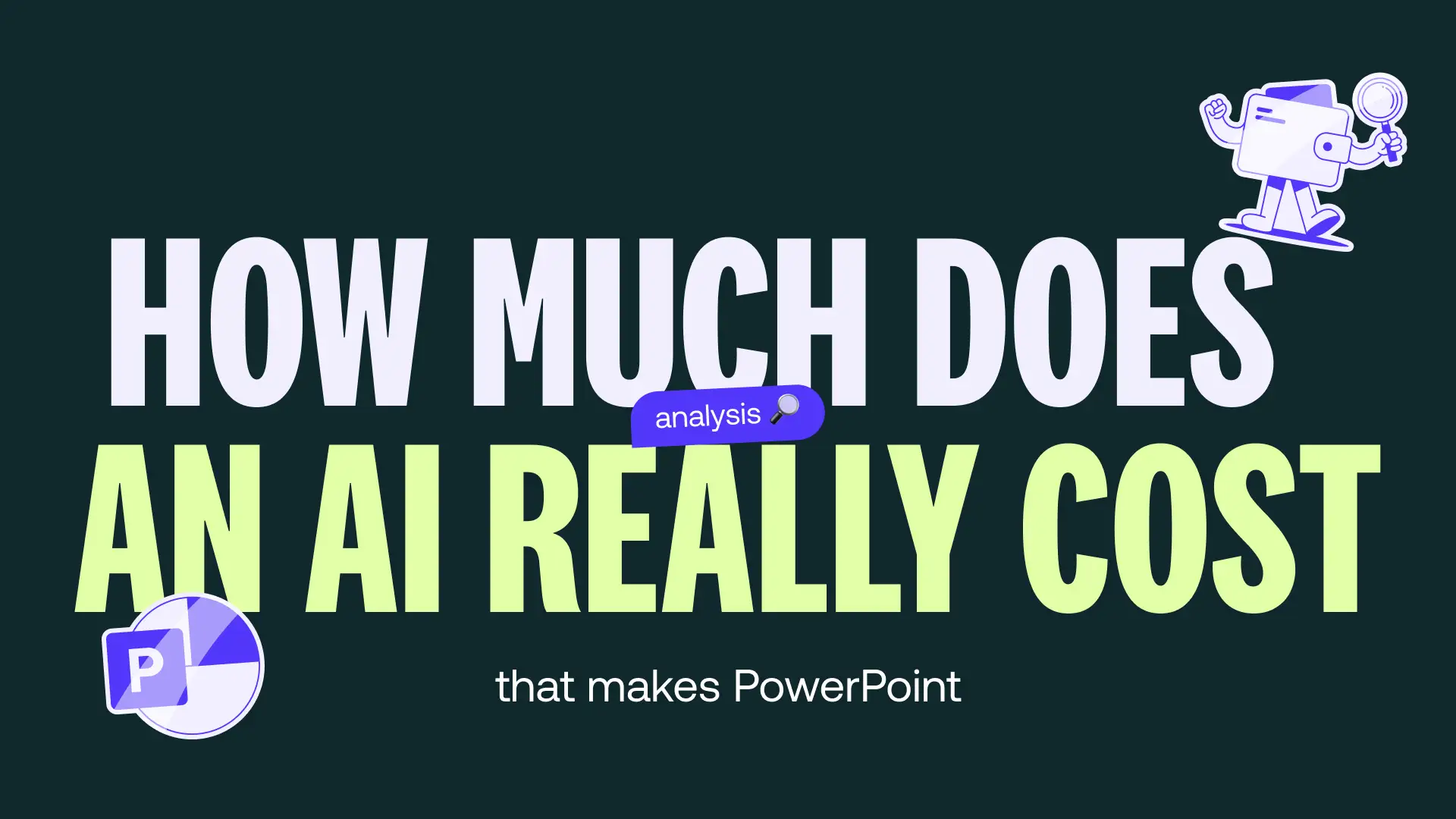How much does an AI that makes PowerPoint really cost?
Discover the real cost of an AI that makes PowerPoint: subscriptions, hidden time, corrections... Is AI really profitable compared to an expert agency?

In recent years, new PowerPoint AI tools (like Gamma.app, Tome, Beautiful.ai, Canva or SlidesAI) have established themselves on the market. Their promise? Generate a professional presentation in a few clicks, for a pittance compared to a PPT expert agency. Enough to seduce marketing, sales, (and finance teams!) in search of speed and savings.
But behind these attractive offers, a question arises: How much does an AI really cost to make PowerPoint? Between the time spent choosing the tool, mastering it, correcting errors or reworking the layout to respect a given graphic charter, the promised economy is sometimes quite relative.
Let's analyze this together!
The promises of AI to make PowerPoint presentations
Slides at the snap of your fingers
The first thing that attracts people about these tools is of course The speed. Who has never spent more time than expected putting together a presentation?
With a generator like Tome or Gamma.app, you only need to provide a starting text to obtain, in a few moments, a series of structured slides. Titles, images, placeholders: everything is already ready to be used.
It is precisely this promise of simplicity that explains the enthusiasm for these solutions: they allow anyone to produce a presentation in a short time, without the need for special skills.
Very accessible costs
The other major advantage put forward by these tools is of course their prizes. Where a professional service represents an investment, AI platforms work on a monthly or annual subscription, with prices that seem ridiculous (at first glance).
A few examples:
- Beautiful.ai offers a Pro plan at around $12 per month.
- Tome charges around $16 per month for unlimited access.
- Gamma.app is between $10 and $20 per month depending on the options.
- Canva Pro amounts to a hundred euros per year and per user.
- SlideSai offers a limited free version, then subscriptions starting at around ten dollars.
With these amounts, it becomes possible for a team of produce a large number of presentations without exploding the budget. No wonder many businesses are interested in it: the promise is attractive, especially when you compare these figures with the cost of a specialized agency.
On paper, therefore, everything seems ideal: an affordable subscription and slides produced in a few minutes. But once you dig a little bit, you quickly realize that the “cost” of an AI presentation is not limited to the subscription.
What really consumes time (and therefore money) are all the invisible steps: learning, preparing, correcting, adjusting.
The hidden costs of an AI-generated presentation
The time to learn and get started
We often forget it: before “saving time”, you must first learn the tool. However, the market is full of solutions (Gamma, Volume, SlidesAI, Beautiful.ai, to name only the main ones) each with its logic, its commands and its limits.
This choice, which seems simple, can quickly become a headache.
And the real cost is there: the time spent by your employees testing, comparing, understanding how each platform works. In a company, this can represent several billable hours... to simply take control of a software that is supposed to make your life easier.
Concretely, the time spent in connection with the learning curve does not appear in the monthly subscription, but remember that it weighs on your overall budget.
The time to write the brief
Let's focus on a persistent myth: AI would “invent” a presentation by itself.
In reality, The machine only organizes what you give it. In other words: if your messages are not clear, if your data is not prepared, you will have an empty slideshow.
This means that your teams need to take the time to write one very precise brief : key messages, figures, strategic angle, your expectations... This work is essential, and takes time!
And he often requires more rigor than with a human designer, who knows how to ask the right questions to clarify your ideas. AI, on the other hand, is content to execute.
The time for round trips and corrections
Another reality that is often underestimated: an AI-generated presentation is almost never usable “as is”. You have to reformulate your prompts, restart several versions, rewrite certain passages, replace poorly chosen visuals...
In practice, this means that the time saved on layout is often Lost in incessant back and forth.
It's a paradox: we use AI to go faster, but we end up devoting almost as much energy to it as with a classic creation!
Time for proofreading and graphic compliance
Even after several iterations, the work is (still) not done. Your teams will have to check line by line: wrong numbers, too vague formulations, irrelevant illustrations...
And above all, AI does not control your brand identity. Colors, fonts, logos, visual style: all this requires manual compliance.
It is not a detail. A presentation that does not respect your charter immediately gives an impression of amateurism.
And in a customer meeting or a management committee, These types of missteps can cost a lot more than a poorly evaluated subscription.
And confidentiality in all of this?
But above all, there is still a major subject: confidentiality. To generate your slides, you must send your content, sometimes sensitive, to third-party servers.
Financial data, strategic information, ongoing projects... are you ready to expose them to an external platform? Some companies, especially in finance or health, simply prohibit these tools. for that reason.
We can temporarily turn a blind eye to the hidden costs of AI. But in the end, a real question remains: is the final result up to par?

Is speed at the expense of quality?
Presentations that don't make a difference
A successful presentation is the one that you remember. With an AI tool to make PowerPoint, you get “correct”, but standardized slides : everyone can produce the same thing, literally. What was an advantage at the beginning of our article is now backfiring!
Result: your speech go unnoticed.
During a commercial pitch or an answer At tender, this lack of differentiation can be expensive.
The absence of real narration
AI knows how to produce content, but it is struggling to create one strategic narrative thread. You end up with a succession of descriptive slides, but without storytelling. And without history, no impact!
In other words: your audience reads your slides, but they don't agree with your vision. In a context of strategic presentation, this parameter is unacceptable.
The risk of approximations
With an AI PowerPoint tool, you are never completely safe factual errors or poorly chosen visuals that you would not have noticed during your proofreading.
Invented figures, inconsistent graphics, irrelevant images... Faced with a decision-making committee, the credibility of your speech can take a hit.
Here, the problem goes beyond the layout: it directly affects the reliability and reputation of your organization.
A diluted brand identity
Your slides are not just a visual support, they are an extension of your brand image. However, The customization of AI PowerPoint presentation tools remains limited : logo, color palette, a few font options... but rarely more.
The result? Slides that look clean, but don't really translate your DNA. In a B2B context, where trust is also at stake in the coherence of your communication, this loss of visual identity can make all the difference.
Clearly, yes, AI does not cost much. But if the rendering is too generic and your teams have to spend hours correcting, harmonizing, and reworking the slides, then the real price goes up quickly. Time spent internally is also money spent.
So the question becomes inevitable: what is the most interesting for your business? Focus on an AI that makes PowerPoint... or entrust the work directly to a specialized agency?
AI vs Agency: where is the real return on investment?
The cost: visible... and invisible
On paper, AI is unbeatable: €10 to €20 per month to generate as many presentations as you want.
But if we integrate the time spent by your teams testing the tool, writing briefs, correcting errors and aligning the slides with your charter, the actual bill is much heavier.
And above all: this time is taken from your employees, who could have focused on tasks with higher added value.
Conversely, an agency represents a higher investment at the start, but you pay for a result turnkey. No endless retouching, no technical back-and-forth : your time is saved to invest it where you really make a difference.
The delay: the misleading argument of AI tools
When asking AI users to create PowerPoints, one of the key arguments is: “It's fast”. We just talked about it: this speed is often only one Facade speed, because behind the generated draft, there are still long hours of corrections and adjustments to manage.
On the other hand, At Mprez, we heard you and we adapted to this reality: thanks to our teams located in Paris, Lisbon and Sao Paulo, we take advantage of the time difference to process your requests quickly, without ever compromising quality.
What do you gain from it? Not a draft to be reworked, but a finalized support, impacting and immediately usable in front of your customers, investors or teams.
Storytelling: the element that makes the difference
We forget it all too often: an effective presentation is not only based on beautiful slides. What makes the difference is the telling. Because a presentation is not a series of numbers or bullet points, it is a story that captures attention, creates emotion and engages your audience.
However, this is precisely where AI reaches its limits. Convincing an investor, engaging a management committee, winning a contract... it requires chosen words, a controlled pace, a staging designed to elicit a reaction. And only humans know how to do that.
At mprez, our storytelling experts support you well beyond design. We work on the speech itself: the progress of your messages, the balance between text and visual, the rhythm of the slides to maintain attention. The result: presentations that are not only informative, but also convincing.
The numbers speak for themselves: The dirty decks that we revisited with storytelling support show on average +30% conversion rate. Clear proof that when you combine visual design and strategic storytelling, the impact is incomparable.
AI and agency PPT: working hand in hand
In view of our analysis, it is clear that the limits of AI become problematic as soon as we talk about presentations with high added value : a call for tenders, the presentation of financial results, a keynote or an intervention in front of investors.
In these contexts, the risk of appearing amateurish or losing credibility is far too high. And if we add the time spent internally correcting and reworking the slides, the low cost displayed by the tool quickly becomes relative: what seemed economical at the beginning is transformed into a hidden expense.
On the other hand, AI is still of interest for more modest uses: internal meetings, work materials, follow-up reporting.
In these cases, the level of requirement is lower, and getting a “correct” document in a few minutes may be enough. Here, the cost/time ratio remains acceptable: a subscription of a few euros per month makes it possible to quickly generate presentations that fulfill their role without the need to invest more.
The AI for creating PowerPoint has something to seduce: fast, affordable, accessible to all. For simple, internal presentations without strategic challenges, this is a practical solution that can save you time.
But as soon as it is a question of convincing, inspiring or defending a strategic project, its limits quickly appear: generic rendering, absent storytelling, hours of invisible corrections. In the end, what seemed economical at the beginning turns into a hidden cost of time, energy and expertise.
On the other hand, Call on the Mprez experts allows you to win on all levels: a clear message, a striking design, a narration adapted to your audience and above all a turnkey result in 48 hours. It is this combination that makes the difference between a “correct” presentation and a presentation that makes an impression, and that allows you to achieve your goals.
So the real question is no longer “how much does an AI presentation cost?” ”, but rather: What return on investment do you want to get from your presentations?
If you want slides that don't just explain, but that convince and transform, contact us right now!


